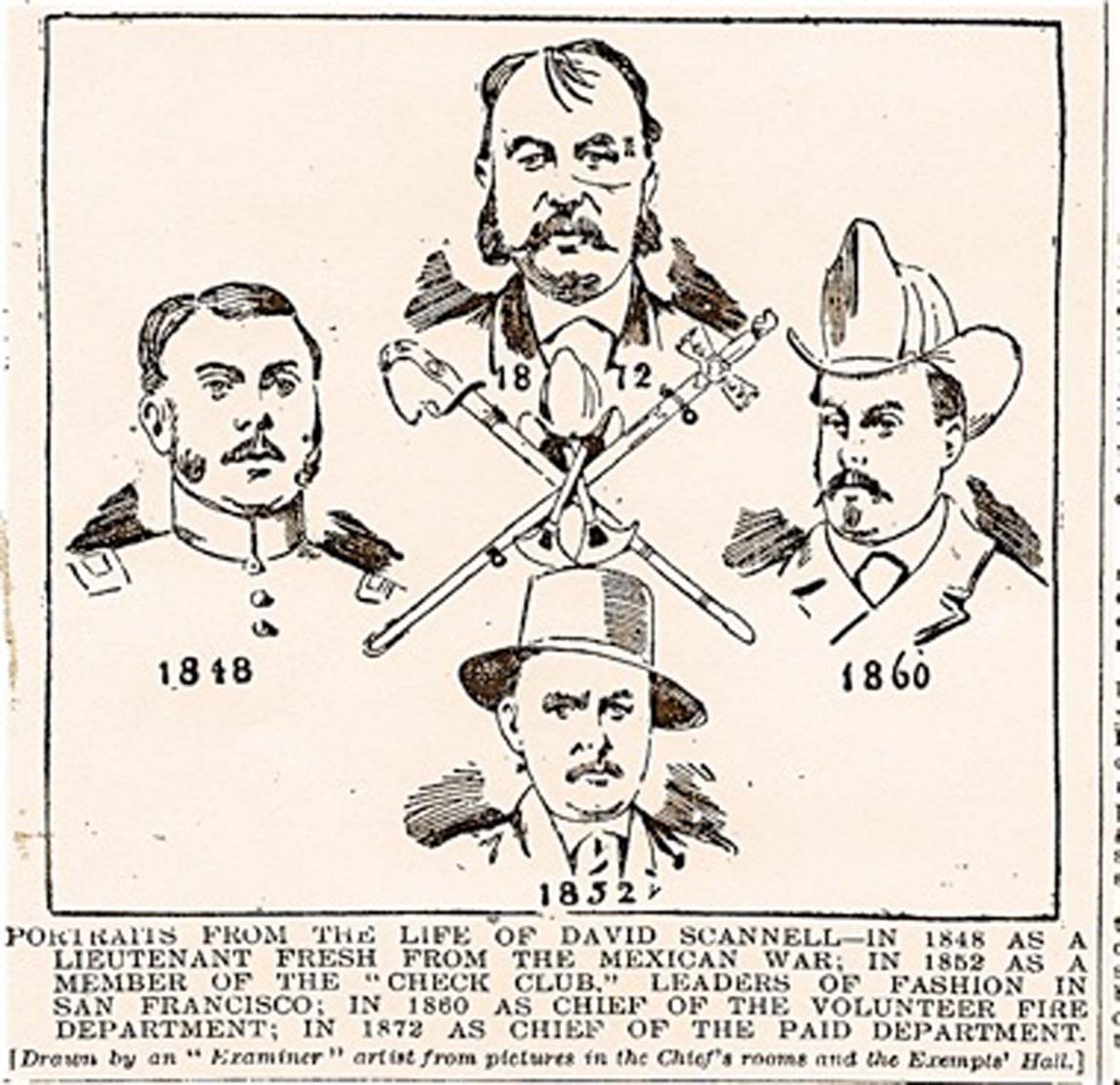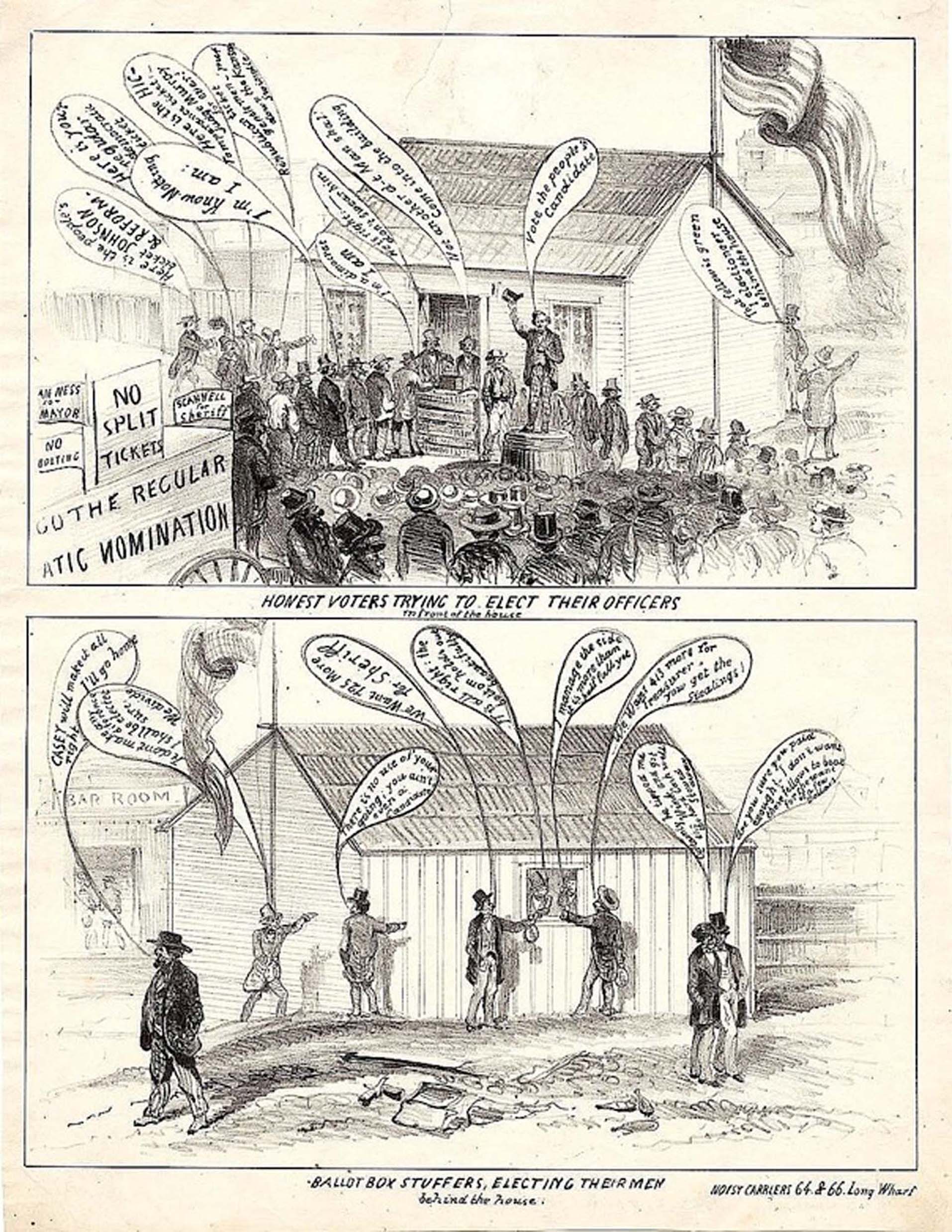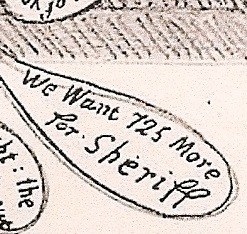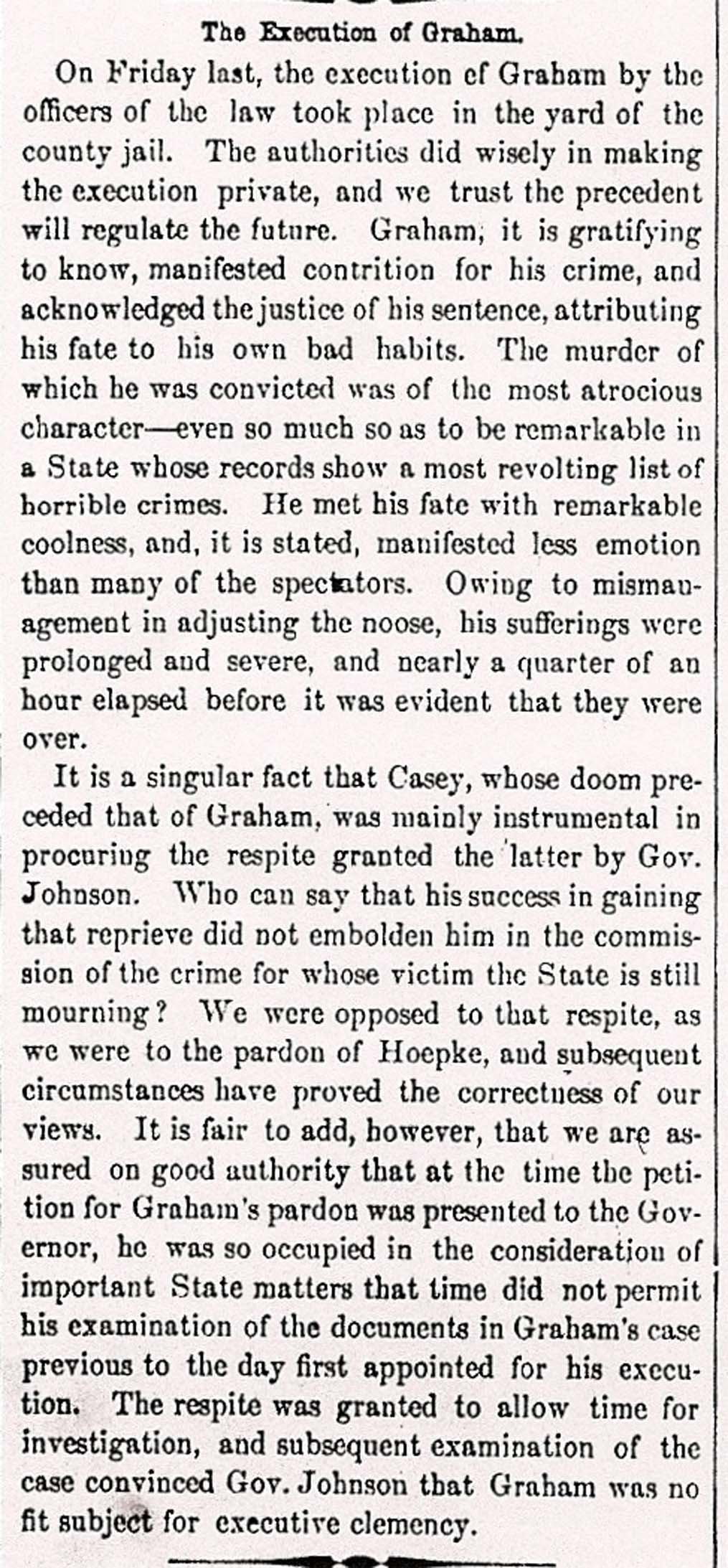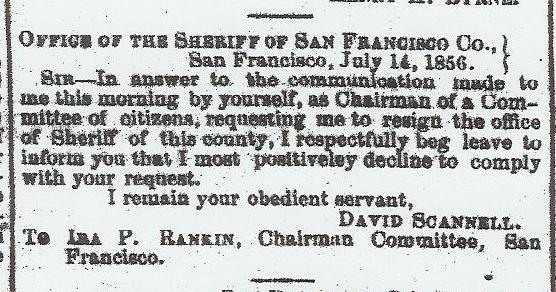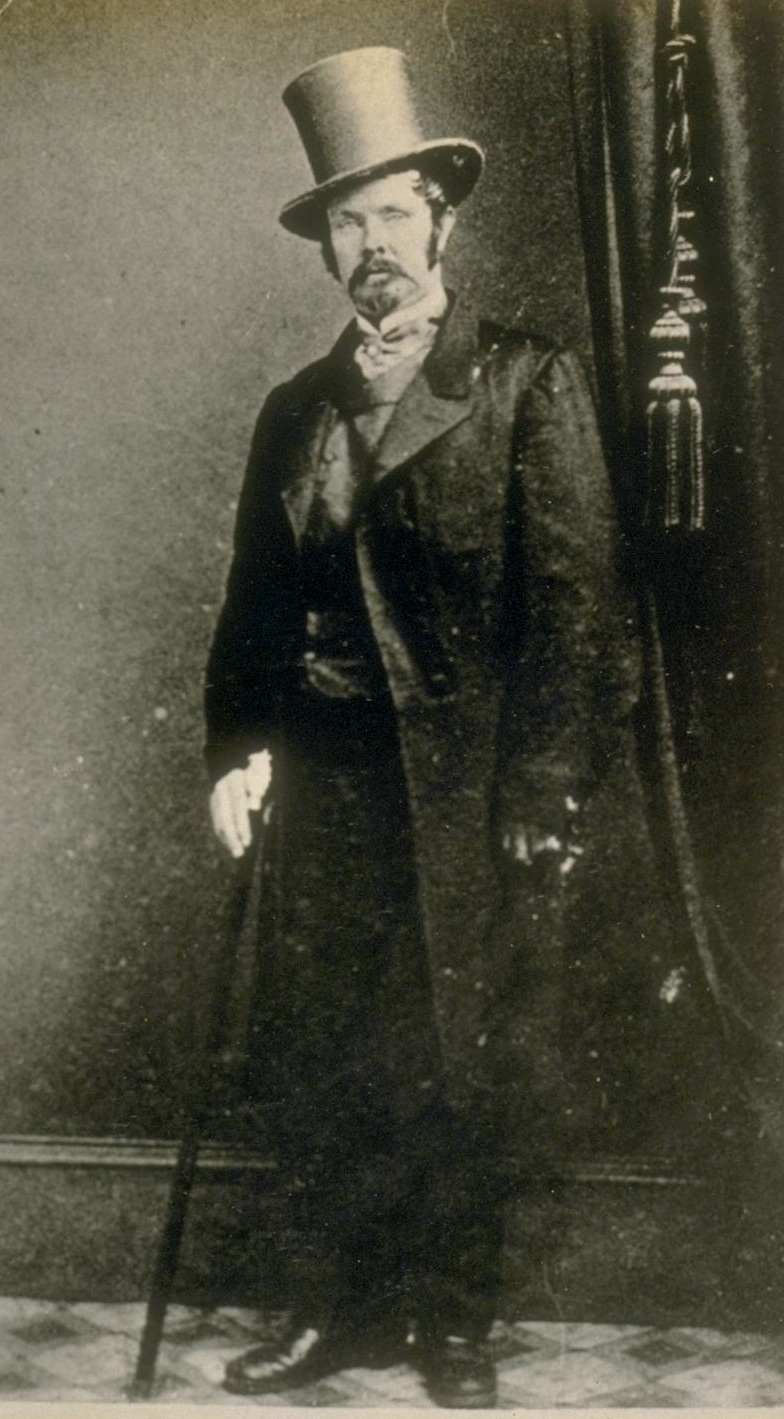In David Scannell’s long and exciting life the most difficult and worst years of his various careers were those served as San Francisco’s Sheriff. A reporter visited his living quarters on the day of his death and noted the many mementos which marked milestones in his life. His mother’s bible, a framed Commission as a Lieutenant in the New York Volunteers, a medal from the Mexican-American War, certificates of induction into San Francisco’s volunteer militia, and many acknowledgements of his time as Chief of the San Francisco Fire Department.
But his room contained no indication that he had ever been San Francisco’s third elected Sheriff. It was said that he did not even talk about that chapter of his life in his later years. (San Francisco Examiner, 3-31-1893)
David Scannell was born on January 31, 1820 in New York City. His father died when he was six years old. He spent his childhood in New York and as young as age twelve he was part of a volunteer fire unit. His life changed dramatically when the Mexican-American War broke out in 1846. Scannell immediately joined a New York infantry unit, was commissioned a lieutenant, and immediately shipped out to Mexico.
The State of New York raised two military units for the war. One unit was Colonel Jonathan Stevenson’s 1st Regiment of New York Volunteers which was sent to San Francisco and other far-flung posts in California with the specific goal of remaining in California as new residents after the war. The other unit, Colonel Ward Burnett’s 2nd Regiment of Foot went directly to Mexico and played a significant role in numerous key battles. David Scannell was a lieutenant in Burnett's 2nd Regiment.
Scannell was on the front lines of ferocious battles at Vera Cruz, Cerro Gordo, Contreras, Churubusco, Chapultepec and Garita de Belen. Of the 805 men in the Second Regiment who went to Mexico, 227 died in battle and 226 were discharged due to wounds or illness. Others died from their wounds or disease shortly upon their return to New York. By 1850, only 105 members of the Regiment were known to still be alive. (The History of New York State, Book XI, Chapter IV. Dr. James Sullivan, editor. Lewis Historical Publishing Co., NY, 1927).
Not long after his return to the firehouses of New York, Scannell developed gold fever and set out for San Francisco by ship in the spring of 1851. He arrived in San Francisco Bay on a wooden side-wheel steamer appropriately named Gold Hunter. Not surprisingly Scannell promptly joined a volunteer fire department, Engine Company No. 1, later known as the Broderick Engine Company.
He also became a founding member of one of the first of San Francisco’s fabled militia units, the San Francisco Blues. The Blues were commissioned by the Governor of California in 1852 with William Gorham as Captain and David Scannell as First Lieutenant. Three years later, Scannell became the founder and Captain of a second militia unit, the Sarsfield Guard. (http://www.militarymuseum.org)
In the fall of 1853, Scannell’s Captain in the Blues, William Gorham, was elected Sheriff. David Scannell was hired as one of Gorham’s seven deputy sheriffs. Scannell also became active with the Democratic Party, attending meetings, rallies and conventions. He developed a life long admiration for Democratic power broker David Broderick and was devastated when Broderick was killed in a duel with David Terry in 1859. An oil portrait of Broderick hung in Scannell’s firehouse home at the time of Scannell’s death in 1893. (SF Examiner, 3-31-1893)
As Sheriff, William Gorham finished his term then let it be known that he would not seek reelection in September 1855. David Scannell decided to seek the office and was considered to be Broderick’s handpicked candidate.
The three political parties held nominating conventions or meetings barely a month before the election. First to nominate were the Know Nothings, also known as the American Party. They nominated the man who had been appointed to finish out Jack Hays’ term as Sheriff, Thomas Johnson (Alta, 8-18-1855). A week later the Democrats held their convention where the vote to nominate a new candidate for sheriff went to six ballots before selecting David Scannell. (Alta, 8-27-1855) The Whig Party followed by nominating Alfred Ellis for the office of Sheriff. Ellis was a wealthy attorney who had been a member of the 1851 Committee of Vigilance.
Scannell narrowly won the election. Alfred Ellis came in a distant third, but Thomas Johnson and Scannell ran a neck and neck race. Of the eight voting districts then in San Francisco, each candidate won four. When the final vote was counted, Scannell won by 70 votes-- 4684 votes to Johnson’s 4614. (Alta, 9-12-1855)
Politics were rough and dirty in San Francisco in the 1850s. Democratic boss David Broderick brought Tammany Hall passion and tactics to San Francisco from New York City. Many of the Democratic “fixers” of the day became the objects of banishment or arrest by the Committee of Vigilance of 1856. One of the most notorious, Billy Mulligan, was employed by Sheriff David Scannell as a jailer. Another, Charles Duane, was the Chief of the volunteer Fire Department.
Scannell entered office under a cloud of suspicion that the Democrats had been stealing elections. For example, Scannell’s friend and fellow Democrat James Casey was elected to the Board of Supervisors earlier in the year even though he was not even a declared candidate. It was more than a coincidence that three of Casey’s friends volunteered to be ballot collectors in the district. (Vigilantes In Gold Rush San Francisco, Robert Senkewicz, Sanford Press, 1985, p. 117) During that same year, at least one ballot box with a false bottom designed to hide illegal ballots was discovered and confiscated. There was a great distrust about the legitimacy of many of the City's elected officials and that suspicion was about to turn to violent outrage.
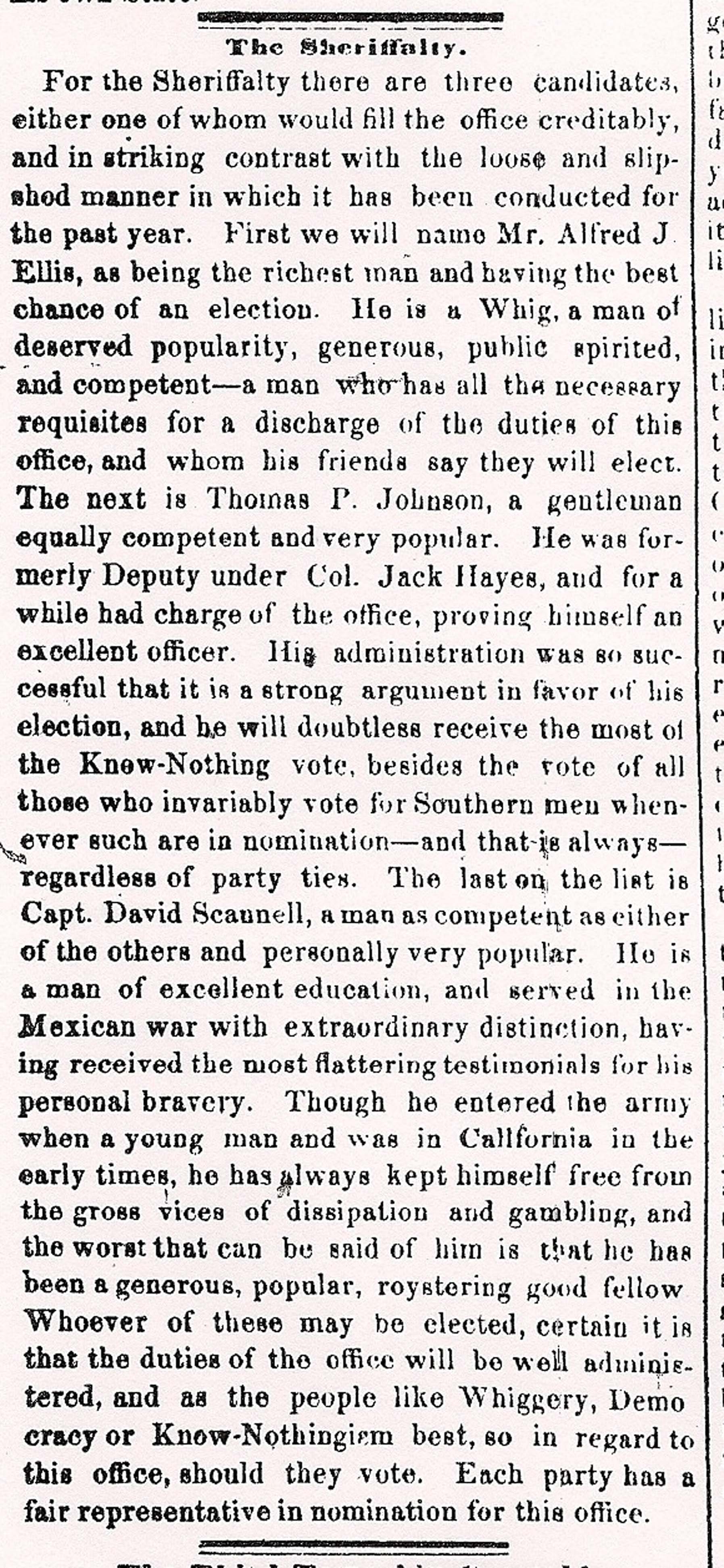
An article from the September 9, 1855 Alta California newspaper profiling the three candidates for Sheriff: Alfred J. Ellis, Thomas P. Johnson, and David Scannell.
Two months after the election the first shoe is dropped that ultimately led to the formation of the Second Committee of Vigilance.
On November 15, 1855 well-known gambler Charles Cora shot and killed the Federal Marshal for the Northern District of California, William Richardson. The dispute was over an insult to Cora’s girlfriend and there were conflicting reports about whether Charles Cora shot in self-defense or in cold blood. Cora was taken to Sheriff Scannell at the Broadway Street jail. The fiery Sam Brannan held a meeting in which he exhorted the crowd to lynch Cora.
The editor of the Daily Evening Bulletin, James King of William, wrote, “What we propose is this: If the jury which tries Cora is packed, either HANG THE SHERIFF or drive him out of town!” (Evening Bulletin, 11-22-1855)
Of course, one of the duties of the Sheriff was to summon jurors for trials, so the Sheriff was often blamed when a jury failed to reach a conviction.
In January 1856, the Cora trial ended with a hung jury. Charles Cora was kept in the Broadway jail to await a second trial.
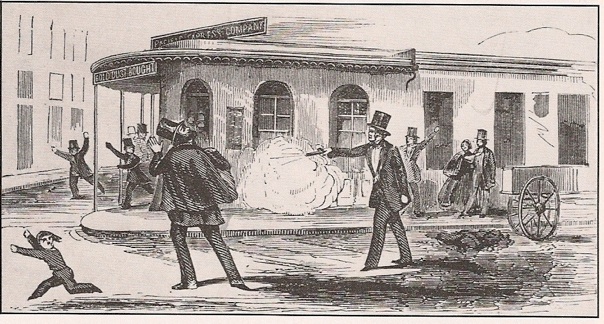
At 5 PM on May 14, 1856, Board of Supervisors member James Casey confronted Evening Bulletin Editor James King of William on the west side of Montgomery Street just north of Washington Street.
Casey demanded "Are you armed?". Then he pulled out a large Navy revolver and shouted "Draw and defend yourself" as he fired one shot into King's chest. King was brought to the Montgomery Block building at 628 Montgomery Street for medical care-- the site where the Transmerica Pyramid building now stands. King died on May 20th at the age of 34.
After the King shooting the Committee of Vigilance was reborn as thousands of agitated citizen volunteers rushed to sign pledges to recreate an alternative justice system. The new Committee of Vigilance issued a public statement that if James King of William died they would apprehend and hang James Casey.
California Governor Neely Johnson, then only 27 years old, came to San Francisco to try to stop the insurrection. Governor Johnson and San Francisco Mayor James Van Ness met with the Vigilante leaders and assured them that Casey would not escape justice. But that would not be enough to stop the resurgance of vigilante justice in San Francisco.
In anticipation of King’s death, on May 18th a disciplined and well-armed contingent of over two thousand members of the Committee of Vigilance, led by their Grand Marshall Charles Doane, marched on the Broadway jail and demanded that both Charles Cora and James Casey be handed over to them for trail. Sheriff Scannell, a group of about 30 deputy sheriffs and some militia volunteers were in no position to resist without considerable bloodshed. The Vigilantes forceably took the two prisoners from their jail cells and began an illegal trial behind closed doors. It is said that David Scannell openly cried at his inability to provide protection for his prisoners. (City of the Golden ‘Fifties, UC Press, 1941, Pauline Johnson, p. 137)
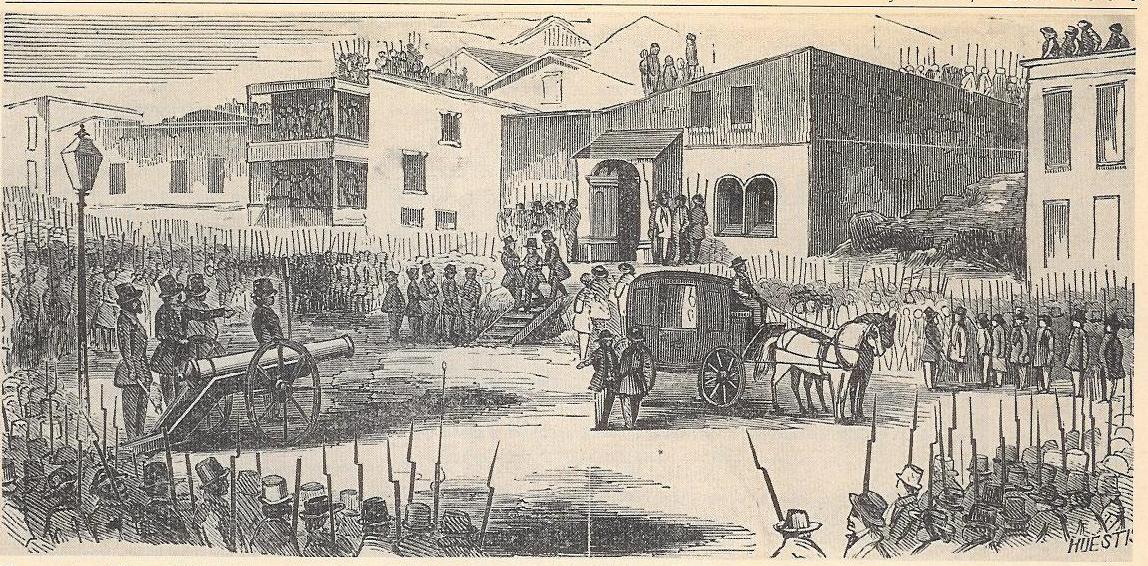
The Broadway Street San Francisco County Jail is taken over by the Committee of Vigiliance May 18, 1856.
The Execution of Nicolas Graham
While the drama of the Committee of Vigilance dominated civic life, the legitimate offices of San Francisco's government continued to function.
As if the events of May 18th were not enough for Sheriff Scannell, he had another matter weighing heavily on his mind. One of his prisoners, Nicholas Graham, had been sentenced to hang on May 2nd but had received a temporary reprieve until May 30th by Governor Johnson. Ironically, it was reported that Graham’s fellow county jail prisoner, James Casey, was instrumental in obtaining the Governor’s temporary reprieve. (The Wide West, 6-1-1856).
Now, with the emergence of the Committee of Vigilance and their recent executions of Cora and Casey, a further reprieve for Nicolas Graham seemed highly unlikely.
It is not known whether the Governor was influenced by the power of the Committee of Vigiliance, but as May 30th deadline approached it became clear that Sheriff Scannell would have to carry out Graham's execution.
Prisoner Nicolas Graham was convicted of stabbing to death a fellow laborer on the steamer Columbia that was at berth in San Francisco Bay. Graham was drunk at the time but readily admitted he committed the murder and was resolved to accept his punishment.
Sheriff Scannell made a wise decision that the execution would not be held in public, unlike the first two court ordered hangings carried out in San Francisco. The Sheriff determined that the event should take place in the yard of the Broadway jail, which was shielded from public view by the jail building and high walls. About one hundred public officials, civic leaders and newspaper editors were sent invitations to attend. (Alta, 5-31-1856)
A gallows was erected in the jail's yard. It was a simple and common structure with one exception: the trap door upon which the condemned man would stand was held in place by a bolt on the underside of the trap. “A strong rope was attached to the end of the bolt, and to which a heavy stone was fastened. This stone was held up by a small cord, which passed up through the scaffold, over which was placed a sharp razor, the edge nearly touching it. The pressure of the foot upon the razor would part the cord, which would throw the weight of the stone upon the strong rope, and draw the bolt from the drop.” (Alta, 5-31-1856)
May 30th arrived without further word about another reprieve from the Governor. Sheriff Scannell and a religious advisor led Graham from his jail cell to the outside gallows. From the raised platform Graham asked for the prayers of those attending and stated, “I forgive you all; I hope you will forgive me.” (Alta, 5-31-1856). Graham was bound and hooded and the noose was placed around his neck. Sheriff Scannell pressed his foot to the blade and the execution took place. Graham’s body was allowed to hang from the rope for almost and hour before his body was turned over to the coroner.
Sheriff Scannell was complimented by the press for the dignity of the event and the same newspapers that only weeks before had called for his resignation stated, “We return him our thanks for his courtesies to the press, and the facilities extended in gaining information of the ceremonies, and also for the copy of the confession of Graham.” (Alta, 5-31-1856)
The Committee of Vigilance was not done with their extra-judicial “cleansing.” Over the next three months, they arrested many others and publicly executed two more men (Hetherington and Brace, neither of whom were ever in the Sheriff’s custody). The Committee of Vigiliance also “banished” a large group of people who they considered a blight on the community. Most of those banished were Irish Democrats. The Committee made a point to round up a number of David Broderick’s political operatives, including Billy Mulligan, and put them on ships to both the East Coast and to Hawaii. One of the Committee’s goals was to demolish Broderick’s Democratic political machine. (Vigilantes in Gold Rush San Francisco, Robert Senkewicz, Stanford Press, 1985, p.173)
A Fight To Remain In Office
The coming days were to become only more stressful for Sheriff David Scannell, as he soon found himself in a courtroom fighting to retain his office as Sheriff.
Only weeks after the execution of Cora and Casey, San Francisco City and San Francisco County were consolidated into a single political jurisdiction. A huge part of the former San Francisco County, from Daly City to the Santa Cruz County boarder, became San Mateo County at this time.
Because of this jurisdictional change, county officials such as the Sheriff were required to resubmit their official bonds of office. Scannell submitted his paperwork on time, but a committee established to approve the new bonds refused to accept Scannell’s bond. He then submitted his documents a different set of backers on a second occasion but his submission was rejected again. At this point the office of Sheriff was declared vacant by both the acting Board of Supervisors and the County Judge. (Alta, 7-12-1856)
Over the next several weeks, several other individuals were “appointed” as Sheriff but Scannell refused to relinquish his title or his office. An election for other City offices was scheduled for November 1856 and the Sheriff’s office was placed on the ballot. Scannell and the Democratic Party refused to submit a candidate, taking the position that the office was not vacant. (Alta, 10-21-1856) So by election time only one candidate was on the ballot for Sheriff-- Charles Doane, the Grand Marshall of the Committee of Vigilance.
After the election, Doane demanded that Scannell vacate the office, but Scannell refused and continued to perform the duties of Sheriff.
The California Supreme Court decided the matter in April 1857 in two related cases, People v. Scannell and Doane v. Scannell. (See, 7 Cal. 432, and 7 Cal. 393) The Court ruled that the law only required Scannell to submit his bonds, it did not require that his bonds be accepted and approved. Therefore, he did all that was required of him by law and did not vacate his office. The Supreme Court ruled that there was no vacancy in the office of San Francisco Sheriff and no need to have the office filled in the election of November of 1856.
During all of this time, and until the end of his term in September 1857, David Scannell continued to carry out the mandated duties of the office of Sheriff. As the election of 1857 approached it was clear that the new political party that had grown out of the Committee of Vigilance, The People’s Party, was overwhelmingly in control of San Francisco politics. So David Scannell chose not to seek reelection.
The Democrats endorsed John Harrison for Sheriff. Harrison was one of Scannell’s chief deputy sheriffs and had previously served under Sheriff William Gorham. It made little difference in the election as the Grand Marshall of the Committee of Vigilance, Charles Doane, easily won the election and took office in late 1857.
Some men might not bounce back from such a traumatic and eventful term of public office, but David Scannell was only just starting his illustrious and celebrated public career in San Francisco. Returning to his roots as a fire fighter, Scannell rejoined the forces of San Francisco’s volunteer firefighters and was elected Chief of the volunteers in 1860. Over the next three decades Scannell devoted his life to the San Francisco Fire Department, first as Chief of the Volunteer forces and then as the first paid Chief of the Department.
In all, Scannell served as Chief three different times, totaling more than 27 years as Fire Department Chief. He was also known as a gourmet cook (City of the Golden Fifties, p. 54 -56) and a bit of a dandy as a dresser, once belonging to a group of men called the “Check Club,” who traveled about town all dressed in black and white checked suits “and big vicuna hats.” (Exmanier, 3-31-1893)
David Scannell was still the Fire Department's Chief at the time of his death at age 73. Scannell's memory has been honored several times by the Fire Department, having a fire boat named in his honor as well as receiving the Department’s medal of valor. (www.sffiremuseum.org).

